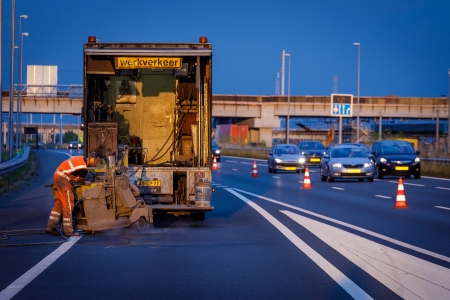Roughly, two types of measures may prevent congestion crashes: measures to prevent congestion itself or measures to prevent congestion-related crashes.
Preventing congestion
Structural congestion and congestion-related crashes can be reduced by decreasing traffic demand and/or (temporary) increasing road capacity. A reduction of traffic demand requires policy-based or legislative interventions leading to changes in travel mode, travel behaviour and vehicle use. Examples are increases of fuel taxation, road pricing [21] or banning the use of certain vehicles on certain roads or at certain times of day. To increase capacity, providing additional lanes is the most obvious measure. When space is too limited and the negative impact of an ever increasing traffic demand is too significant, utilisation measures can be taken, such as deploying peak-hour lanes or storage lanes (bufferstroken) during certain periods of the day.
Preventing congestion-related crashes
Congestion-related crashes can be prevented by both roadside and in-vehicle systems.
Roadside systems
In the Netherlands, MTM systems are applied; particularly Automated Incident Detection (AID) systems that are part of Dynamic Traffic Management (DTM). AID systems are aimed at reducing travel speeds when congestion is imminent or when an incident has occurred (see the question How much have congestion alert systems contributed to crash prevention?). Signalling (essential for these systems) is present on 48% of all national roads (this converts to 60% of the total length of driving lanes) [22]. Expansion of this system may have a positive effect on preventing congestion-related crashes [17].
In-vehicle systems
In-vehicle systems includes systems to prevent crashes, also during congestion, such as forward collision warning (FCW), adaptive cruise control (ACC), lane departure warning assistant (LDWA) and assisted braking (see SWOV fact sheet Intelligent Transport and Advanced Driver Assistance Systems (ITS and ADAS)). By no means all vehicles in the Netherlands are equipped with these technologies, and moreover, when the technology is present, it is often not enabled or is even deliberately disabled [23] [24]. As yet, the effect of these systems on congestion crashes is not conclusive. Some systems are of little or no help in crash prevention, the effect of other systems is unknown and a few have a considerable (positive) effect on road safety (also when there is no congestion). It is unknown whether ITS and ADAS also have unwanted side effects, although some systems could lead to distraction or reduced alertness. This negative effect could be greater in situations with traffic congestion.
